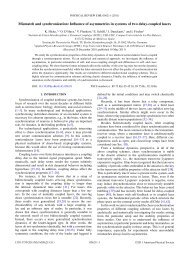CHAPTER 5. BRANES 64meaning that the level-matching c<strong>on</strong>diti<strong>on</strong> got somewhat altered, and[ (K ) 2 ( ) ]WR2α ′ M 2 = α ′ +R α ′ + 2N L + 2N R − 4. (5.17)This last equati<strong>on</strong> hides a symmetry, namely it is invariant under the simultaneoustransformati<strong>on</strong>s {R −→ ˜R = α ′ R −1 ,(5.18)W ←→ K.This symmetry is exactly what is called T-duality, and it teaches us that for closedstrings <strong>compact</strong>ificati<strong>on</strong> <strong>on</strong> a circle <str<strong>on</strong>g>of</str<strong>on</strong>g> radius R is physically equivalent to, and evenindistinguishable from, <strong>compact</strong>ificati<strong>on</strong> <strong>on</strong> a circle <str<strong>on</strong>g>of</str<strong>on</strong>g> radius α ′ R −1 . You might w<strong>on</strong>derwhy it is called a duality and not a symmetry. The reas<strong>on</strong> is simple: it is <strong>on</strong>ly asymmetry in the closed string case, but not in the open string case as we will so<strong>on</strong> findout. However, we will still be able to map soluti<strong>on</strong>s <str<strong>on</strong>g>of</str<strong>on</strong>g> <strong>on</strong>e theory to soluti<strong>on</strong>s <str<strong>on</strong>g>of</str<strong>on</strong>g> another,hence we are left with a duality. According to [11] (p.38), the “T” stands for “targetspace,” being as we map different space-time c<strong>on</strong>figurati<strong>on</strong>s into <strong>on</strong>e another.At any rate, the effect <str<strong>on</strong>g>of</str<strong>on</strong>g> performing a T-duality transformati<strong>on</strong> <strong>on</strong> the closed stringalso entails that <strong>on</strong>e changesX 25R −→ −X 25R ; X 25L −→ X 25L . (5.19)This mapping is obvious for the zero modes, in which case it simply follows from Eqs.5.8 and 5.9, but for the other modes we need to impose this. We can do this, as thischanges nothing to the physics <str<strong>on</strong>g>of</str<strong>on</strong>g> our theory. This map leaves all physical quantities<str<strong>on</strong>g>of</str<strong>on</strong>g> the theory unchainged, and hence truely c<strong>on</strong>stitutes a symmetry. This allows <strong>on</strong>e toexpress the theory using an equivalent coordinate ˜X defined aswith the generic expansi<strong>on</strong>˜X 25 (σ, τ) = X 25L (τ + σ) − X 25R (τ − σ), (5.20)˜X 25 (σ, τ) = ˜x 25 + 2α ′K R σ + 2RWτ25 + oscillators. (5.21)We note that R can take <strong>on</strong> a specific value at which the theory is self-dual, namelyR = √ α ′ . At this radius, the massless closed string spectrum gets modified so as toacquire two SU(2) gauge groups, <strong>on</strong>e left-moving and <strong>on</strong>e right-moving. For a shortdiscussi<strong>on</strong>, see [12] §3.3.It is worth pointing out a major difference between Kaluza-Klein (KK) <strong>compact</strong>ificati<strong>on</strong>and T-duality. With KK <strong>compact</strong>ificati<strong>on</strong>, what <strong>on</strong>e does is <strong>compact</strong>ify adimensi<strong>on</strong>, so that <strong>on</strong>e can make it “disappear” by choosing it infinitally small (R −→ 0limit), in which case its physics decouple from that in the other dimensi<strong>on</strong>s. This ispossible, because in KK theory, <strong>on</strong>e <strong>on</strong>ly has a mass-squared-like factor going as ∼ R −2 .With T-duality however, two mass-squared-like terms appear, <strong>on</strong>e going as ∼ R −2 andanother going as ∼ R 2 . You simply cannot make them both disappear simultaneously!
CHAPTER 5. BRANES 65<str<strong>on</strong>g>Open</str<strong>on</strong>g> stringsNext, we turn ourselves to the case <str<strong>on</strong>g>of</str<strong>on</strong>g> the open string. We c<strong>on</strong>sider an open string obeyingNeumann boundary c<strong>on</strong>diti<strong>on</strong>s in all 25 spatial dimensi<strong>on</strong>s, for which the expansi<strong>on</strong>was given by Eq. 2.41, which we refresh:X µ (σ, τ) = x µ + l 2 sp µ τ + il s∑n≠01n αµ ne −inτ cos (nσ).Again <strong>compact</strong>ifying the X 25 dimensi<strong>on</strong>, this time we do not need to include any specialextra terms as in the closed string case. It remains true however that the p 25 momentumcomp<strong>on</strong>ent becomes quantized, so that p 25 = nR −1 with n ∈. Further recalling thatwe defined α µ 0 = l sp µ , we find for the expansi<strong>on</strong> <str<strong>on</strong>g>of</str<strong>on</strong>g> X 25 :∑X 25 (σ, τ) = x 25 + l s α0 25 1τ + il sn α25 n e −inτ cos (nσ). (5.22)Although we did not do so before because it did not bare any interesting features withit at the time, we will now also expand this into left- and right-movers. We may do so,as we can c<strong>on</strong>sider the oscillati<strong>on</strong>s <str<strong>on</strong>g>of</str<strong>on</strong>g> an open string to be superpositi<strong>on</strong>s <str<strong>on</strong>g>of</str<strong>on</strong>g> left- andright-movers that combine into standing waves. We will do so, because <str<strong>on</strong>g>of</str<strong>on</strong>g> course, wewould like to be able to formulate the theory using a “dual coordinate” ˜X 25 , just as inthe closed string case. This expansi<strong>on</strong> amounts t<strong>on</strong>≠0XR 25 (τ − σ) = x25 − ˜x 25+ 1 2 2 l sα0 25 (τ − σ) + i l ∑s 12 n α25 n e −in(τ−σ) , (5.23)n≠0∑XL 25 (τ + σ) = x25 + ˜x 25+ 1 2 2 l sα0 25 (τ + σ) + i l s2n≠01n α25 n e −in(τ+σ) , (5.24)where again ˜x 25 is an as-<str<strong>on</strong>g>of</str<strong>on</strong>g>-yet arbitrary c<strong>on</strong>stant that cancels in the sum. The biggestdifference with the closed string case, is that this time there is <strong>on</strong>ly <strong>on</strong>e set <str<strong>on</strong>g>of</str<strong>on</strong>g> modes (i.e.,there are no ˜α’s). T-dualizing by sending R −→ ˜R = α ′ R −1 will again send X R −→ −X Rand X L −→ X L , and so we define the dual coordinate ˜X 25 (σ, τ) = X L − X R , whichexplicitely becomes∑˜X 25 (σ, τ) = ˜x 25 + l s α0 25 1σ + l sn α25 n e −inτ sin(nσ). (5.25)We see that the zero-mode gets multiplied by σ instead <str<strong>on</strong>g>of</str<strong>on</strong>g> τ, as was the case for X 25 ,and that the cos (nσ) got exchanged for −i sin(nσ). This hints at something that turnsout to be true, namelyn≠0∂ σ X 25 = ∂ τ ˜X25 , (5.26)∂ τ X 25 = ∂ σ ˜X25 , (5.27)
















